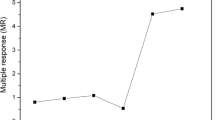Abstract
This paper describes a fast, simple and novel extraction method for total selenium and selenium species determination in food samples. Parameters influencing extraction, such as sonication time, extracting media, temperature, sample mass, ultrasound amplitude and sample/enzyme mass ratio were investigated. The enzymatic hydrolysis proposed, enhanced by probe sonication, allowed the quantitative extraction of selenium in chicken muscle, liver, kidney and feed (97, 93, 95 and 102%, respectively) in 2 min, maintaining the original Se-species integrity. Total Se content of the samples was determined using inductively coupled plasma mass spectrometry. Se-species were identified and quantified using high-performance liquid chromatography in conjunction with inductively coupled plasma mass spectrometry. Chromatographic analyses were carried out under two chromatographic conditions and led to the identification of SeMet in all samples. The accuracy of the proposed method was assessed using certified reference materials as well as microwave digestion. Potential advantages of the proposed method over traditional hydrolysis are speed, simplicity and safety of the procedure.



Similar content being viewed by others
References
Luque de Castro MD, Jiménez-Carmona MM (1998) TrAC–Trend Anal Chem 17:441–447
Nascentesa CC, Kornb M, Arrudaa MAZ (2001) Microchem J 69:37–43
Brunori C, Ipolyi I, Macaluso L, Morabito R (2004) Anal Chim Acta 510:101–107
Lima EC, Barbosa F, Krug FJ, Silva MM, Vale MGR (2000) J Anal Atom Spectrom 15:995–1000
Luque de Castro MD, da Silva MP (1997) TrAC–Trend Anal Chem 16:16–24
Ashley K, Andrews RN, Cavazos L, Demange MJ (2001) J Anal Atom Spectrom 16:1147–1151
Luque-García JL, Luque de Castro MD (2003) TrAC–Trend Anal Chem 22:41–47
Santos C, Alava-Moreno F, Lavilla I, Bendicho C (2000) J Anal Atom Spectrom 15:987–992
Pérez-Cid B, Lavilla I, Bendicho C (1998) Anal Chim Acta 360:35–39
López-Gonzálvez A, Probanza A, Galli V, Hevia C, Marín A, Muñoz-Campos F, Barbas C (1999) Chem Ecol 16:297–301
Combs CF, Gray WP (1998) Pharmacol Ther 79:179–192
Pyrzynska K (2001) Talanta 55:657–667
Combs GF, Combs SB (eds) (1986) The role of selenium in nutrition. Academic, New York
Daniels LA (1996) Biol Trace Elem Res 54:185–199
McSheehy S, Mester Z (2003) TrAC–Trend Anal Chem 22:311–326
Dernovics M, Stefánka Z, Fodor P (2002) Anal Bioanal Chem 372:473–480
Gilon N, Potin-Gautier M, Astruc M (1996) J Chromatogr A 750:327–334
Gilon N, Astruc A, Astruc M, Gautier M (1995) Appl Organomet Chem 9:623–628
Capelo JL, Ximénez-Embún P, Madrid-Albarrán Y, Cámara C (2004) Anal Chem 76:233–237
Moreno P, Quijano MA, Gutiérrez AM, Pérez-Conde MC, Cámara C (2001) J Anal Atom Spectrom 16:1044–1050
Larsen EH, Sloth J, Hansen M, Moesgaard S (2003) J Anal Atom Spectrom 18:310–316
Stefánka ZS, Ipolyi I, Dernovics M, Fodor P (2001) Talanta 55:437–447
B’Hymer C, Caruso JA (2000) J Anal Atom Spectrom 15:1531–1539
Vonderheide AP, Wrobel K, Kannamkumarath SS, B’Hymer C, Montes-Bayón M, Ponce de León C, Caruso JA (2002) J Agr Food Chem 50:5722–5728
Ponce de Leon CA, Sutton KL, Caruso JA, Uden PC (2000) J Anal Atom Spectrom 15:1103–1107
Abou-Shakra FR, Rayman MP, Ward NI, Hotton V, Bastina G (1997) J Anal Atom Spectrom 12:429–433
Schrauzer GN (2000) J Nutr 130:1653–1656
Schrauzer GN (2003) Adv Food Nutr Res 47:73–112
Acknowledgements
The authors wish to thank to Ana Serrano for her contribution to this work.
One of the authors (A. Cabañero) wishes to thank Complutense University for their support through a predoctoral fellowship.
Author information
Authors and Affiliations
Corresponding author
Rights and permissions
About this article
Cite this article
Cabañero, A.I., Madrid, Y. & Cámara, C. Enzymatic probe sonication extraction of Se in animal-based food samples: a new perspective on sample preparation for total and Se speciation analysis. Anal Bioanal Chem 381, 373–379 (2005). https://doi.org/10.1007/s00216-004-2798-4
Received:
Revised:
Accepted:
Published:
Issue Date:
DOI: https://doi.org/10.1007/s00216-004-2798-4




